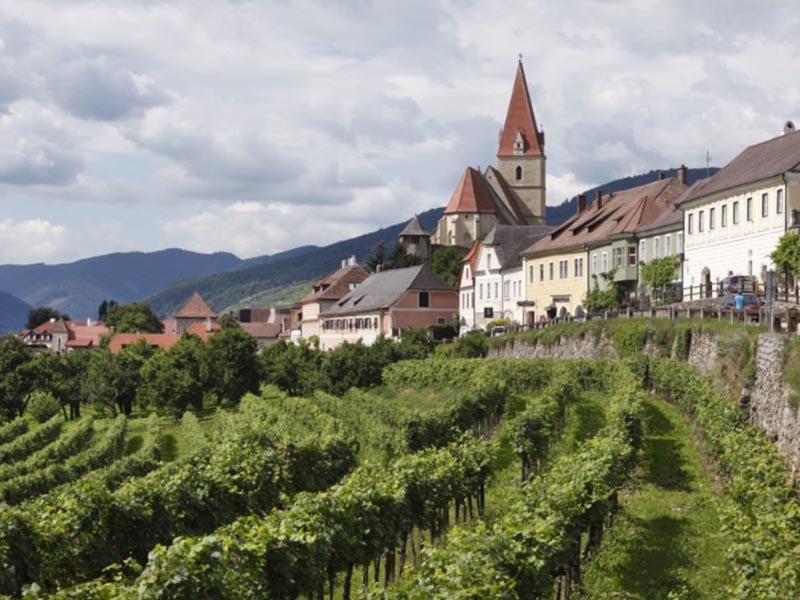The Hills are Alive
- Posted on
- Posted in Austria, Gruner Veltliner, Muscat, pinot gris/pinot grigio, pinot noir, Riesling
- 0

The hills are alive with the sound of corks being opened, rather than music, as City Vino features Austrian wines this week for our tastings on Friday, July 8, and Saturday July 9.
For your enjoyment here are some Austrian wine facts:
- Austria accounts for less than one percent of the wine in the world, producing 28 million cases a year. Three-quarters of the wine is consumed domestically.
- Austrian wine law allows for 35 grape varieties, of which 22 are white. Climate limits the red grape varieties that don't get enough warmth to fully ripen, so most approved grapes are white.
- While the beautiful alps provide a gorgeous backdrop in The Sound of Music, grapes are not grown there, due to the very cool climate. In Austria, most of the vineyards are located to the eastern side of the country.
- Speaking of climate here, Austria’s wine regions are located predominantly around the 47th and 48th For comparison, the following places are at the 47th parallel: Olympia, in WA; Duluth, in MN; Beaune, in Burgundy, France; and the Alps, in Switzerland. At the 48th parallel, you’ll find: a tad north of the state of Maine; a short drive north of Seattle, in WA; and the Haut-Rhin, in Alsace, France.
- A third of all wines produced in Austria are made from the grape Grüner Veltliner, due to its cold hardiness.
- The Wachau region is a UNESCO World Heritage Site, located west of Vienna, along the Danube River. With 3,500 acres of vines and a climate mitigated by the warming of the sun reflecting off the river, some excellent Rieslings are from here.
- The best sweet wines from Austria come from near the Neusiedlersee area, in Burgenland. The Neusiedlersee is a shallow lake that separates Austria from Hungary. The location gets fog in the morning, and sun in the afternoon, which is the perfect recipe for having noble rot--also called botrytis--in the vineyard. This “rot” dehydrates the grapes, concentrating the sugars, and leaves behind hallmark flavors of orange marmalade and honeysuckle. This “rot” also accounts for the luscious Sauternes from France, and Tokaj from Hungary.
- Vienna has more urban vineyards than any metropolitan city in the world with 1,600 acres.
- The term "Gemischter Satz" means a field blend, where different grape varieties are planted, harvested, and fermented together. Common grapes used to produce these wines are Grüner Veltliner, Riesling, Chardonnay, and Weissburgunder (Pinot Blanc). The grapes Welschsriesling, Neuburger, Müller-Thurgau, Sauvignon Blanc, Traminer, and Gelber Muscateller (Yellow Muscat) can also be used.
- In 1985, some Austrian wineries were adulterating their wines with diethylene glycol which produced a wine with more body and sweetness. A huge scandal ensued, and the wine industry here had its reputation tarnished. Out of the scandal arose high quality standards.
Now, let us get to our Austrian wines.
Our first wine is the 2021 BioKult Naken Pét-Nat, from Burgenland Austria, and is 90 percent Pinot Gris and 10 percent Muscateller (Muscat Blanc à Petits Grains which is the Moscato d’ Asti grape but in a dry format here). Pét-Nat or, more fully, Pétillant Naturel informs you that the wine is slightly sparkling, and the sparking was produced in the bottle without having been clarified. Meaning there will be some dust to be expected in the bottle. The wine takes its color from the Pinot Gris’s grape skins that are allowed to have contact with the juice through fermentation. Truly a Naken wine with not much help from the winemaker. Highly aromatic with notes of ginger, orange peel, peony, peach, citrus, creamy body, and light tannins (because of the skin contact).
Our field blend is the 2019 Hugl Weine Gemischter Satz, from Niederösterreich in Austria, and is comprised of are Grüner Veltliner, Riesling, and Gelber Muscateller. The grapes for this wine are grown within the city limits of Vienna, although the winery itself is up in the northwest region of the country. A very refreshing white wine featuring jasmine, white pepper, and ripe orchard fruits.
The 2020 Josef Bauer Feuersbrunn Riesling, from Wagram, Austria, is next. This dry crisp Riesling sings with peach, tangerine, lime, and lime zest aromas. It is mouthwateringly delicious, with green and orange citrus on the palate. This wine will improve with a few years of aging. Yes, a white that can be aged!
Next up is the 2019 Heinrich Hartl III Pinot Noir Classic, from the Thermen region in Austria. This wine is 100 percent Pinot Noir, and has lovely aromas of cherries, berry compote, and a dash of smoke. The flavors show more black cherry, pepper, and bitter cocoa.
Let us taste a sampling of wines from Austria together this coming Friday and Saturday, and perhaps break out in song. On second thought, maybe not.

Comments
Be the first to comment...